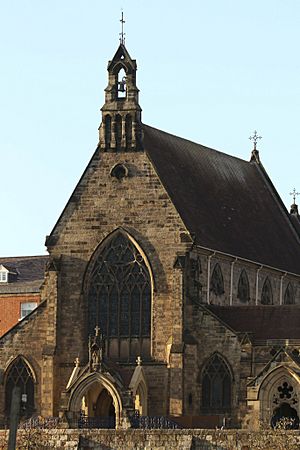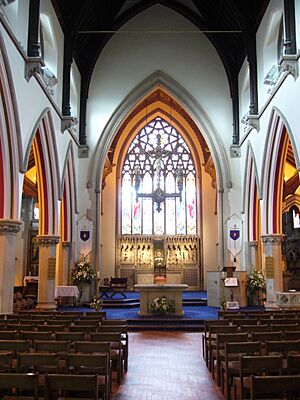Shrewsbury Cathedral facts for kids
Quick facts for kids Shrewsbury Cathedral |
|
|---|---|
| Cathedral Church of Our Lady Help of Christians and Saint Peter of Alcantara | |
 |
|
| Lua error in Module:Location_map at line 420: attempt to index field 'wikibase' (a nil value). | |
| Location | Shrewsbury, Shropshire |
| Country | England |
| Denomination | Roman Catholic |
| Website | shrewsburycathedral.org |
| History | |
| Status | Cathedral |
| Consecrated | 1856 |
| Architecture | |
| Heritage designation | Grade II* |
| Designated | 1953 |
| Architect(s) | E. W. Pugin |
| Style | Gothic Revival |
| Groundbreaking | 1852 |
| Completed | 1856 |
| Administration | |
| Diocese | Shrewsbury (since 1856) |
| Province | Birmingham |
Shrewsbury Cathedral, officially known as the Cathedral Church of Our Lady Help of Christians and Saint Peter of Alcantara, is a Roman Catholic cathedral in the town of Shrewsbury, England. A cathedral is the main church in an area called a diocese, and this one is the main church for the Diocese of Shrewsbury.
This cathedral is special because it's the only one in the county of Shropshire. Most other English counties have a Church of England cathedral, but Shropshire does not. Because of its historical importance, it is listed as a Grade II* building, which means it is a very important building worth protecting.
Contents
History of the Cathedral
Building the Cathedral
The plan to build the cathedral started with John Talbot, 16th Earl of Shrewsbury. He hired a famous architect named Augustus Welby Northmore Pugin. Sadly, both men died in 1852 before construction could begin.
John Talbot's nephew, Bertram, became the new Earl and offered to pay for the cathedral. The job of designing it was given to Edward Pugin, the son of the original architect. The first plan was for a very large cathedral with a tall spire.
However, builders soon found a layer of sand under the ground where the cathedral was being built. This meant the foundation wasn't strong enough for a huge, heavy building. The plans had to be changed to a smaller church without a spire. The Earl of Shrewsbury agreed to pay for this smaller version, which cost £4,000. He passed away just three months before it was finished. The cathedral was completed and officially opened in 1856.
Celebrating 100 Years
On October 30, 1956, a special service called a Mass was held to celebrate the cathedral's 100th anniversary. Important church leaders, including bishops from across England and Wales, came to Shrewsbury for the celebration.
Changes and Discoveries
In 1984, the inside of the cathedral was updated to match new guidelines for church services. A new altar (the table used in services) was made from local Grinshill stone.
More recently, in 2019, Bishop Mark Davies decided to restore the cathedral's interior to look like it did when it was first built. During this work, a wonderful discovery was made. Hidden under layers of paint were amazing wall paintings from the 1800s. An artist named Joseph Aloysius Pippet had painted them. The paintings were covered up in the 1970s and 1980s. Experts worked to carefully restore these beautiful, historic artworks.
Stunning Stained-Glass Windows
The cathedral is famous for its beautiful stained-glass windows. Many of the older windows were made by a company called Hardman & Co..
There are also seven windows made in the early 1900s by Margaret Agnes Rope, a talented artist who was inspired by the Arts and Crafts movement. She was the daughter of a local doctor and had a studio in London. Later in her life, she became a Carmelite nun. Her cousin, M. E. Aldrich Rope, was also a stained-glass artist.
War Memorial
Margaret Agnes Rope also designed the cathedral's war memorial. It honors the 63 men from the church's community who died in World War I. The memorial shows a sculpture of Mary holding Jesus, known as a Pietà.
Below the sculpture is a wooden plaque with the badge of the local army regiment, the King's Shropshire Light Infantry. The names of the soldiers are listed below the plaque.
Where to Find the Cathedral
Shrewsbury Cathedral is located on a street called Town Walls. It stands next to the old town wall, inside a large bend of the River Severn right in the center of Shrewsbury.
Gallery
See also
 In Spanish: Catedral de Nuestra Señora Auxiliadora y San Pedro de Alcántara (Shrewsbury) para niños
In Spanish: Catedral de Nuestra Señora Auxiliadora y San Pedro de Alcántara (Shrewsbury) para niños
- Listed buildings in Shrewsbury (southeast central area)





